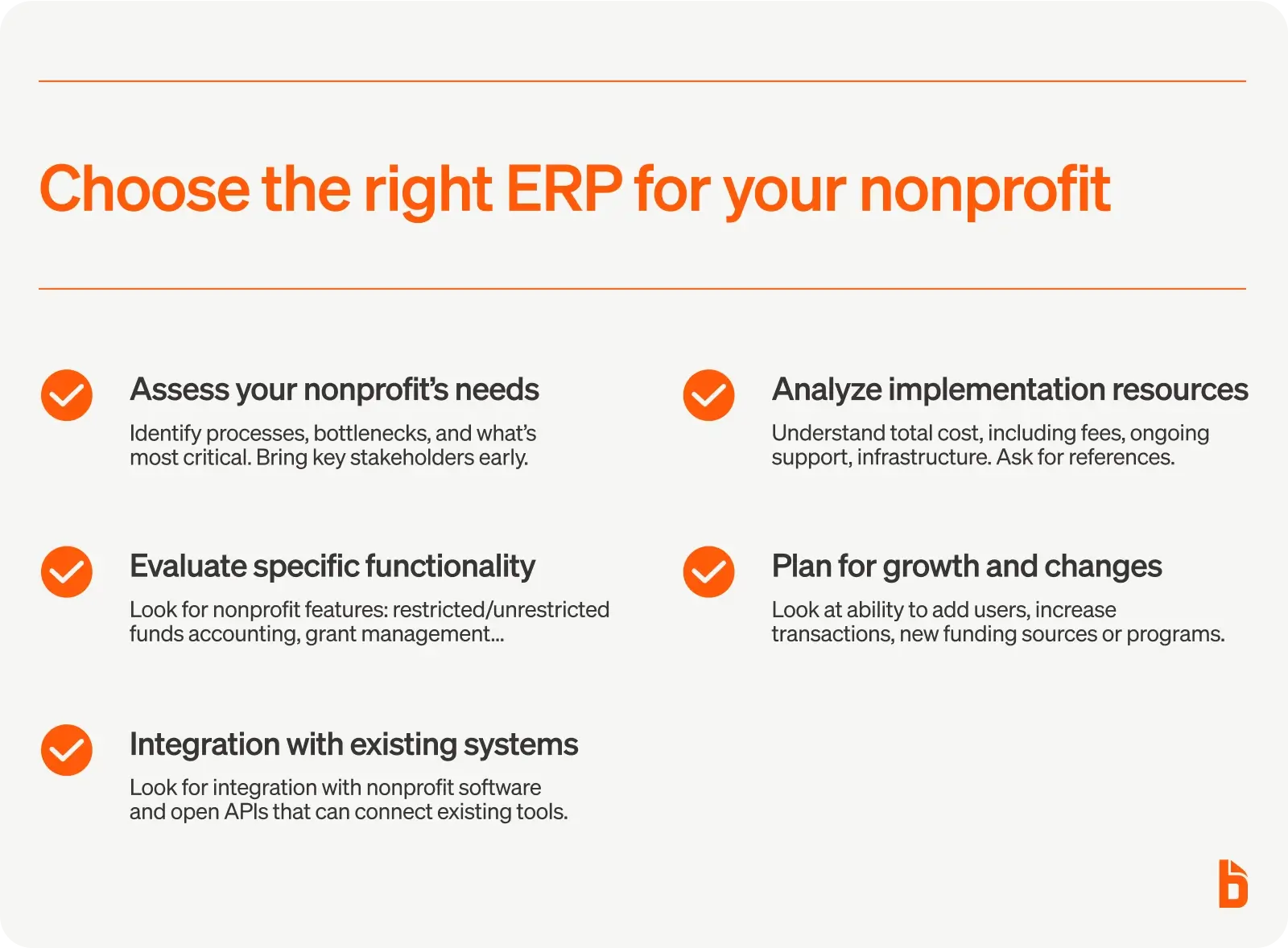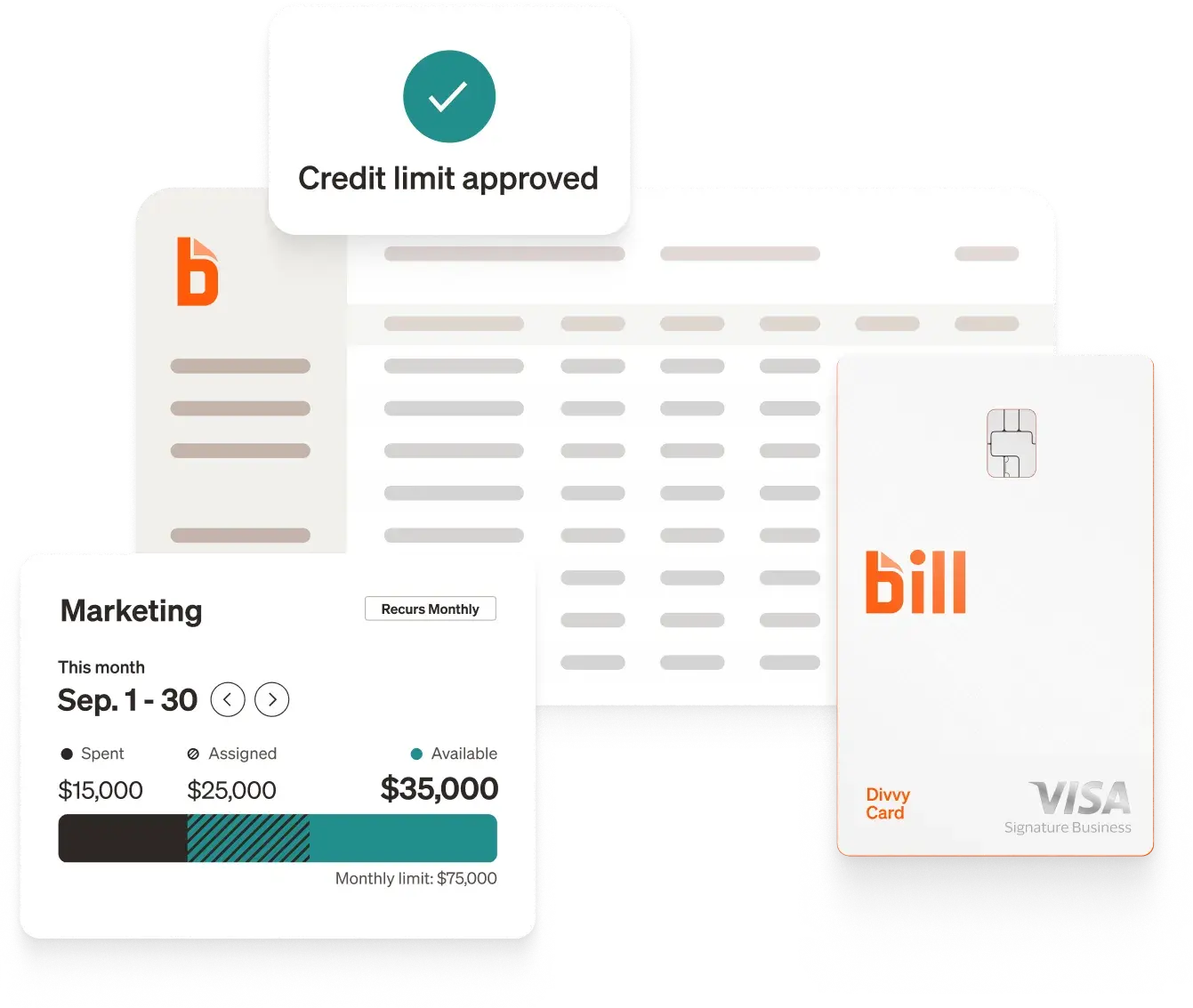The right ERP solution can add tremendous efficiency, visibility, and transparency to the way a nonprofit manages resources, tracks outcomes, and demonstrates stewardship.
This post explores the top ERP systems that address the unique financial and operational challenges faced by nonprofits and mission-driven organizations.
What is an ERP for nonprofits?
A nonprofit ERP (enterprise resource planning) system is a software solution designed to meet the unique finance, operations, and compliance needs of mission-driven organizations. Unlike standard ERPs, which focus on profit-generating business processes, nonprofit ERPs are built around fund stewardship, program effectiveness, and mission impact.
These specialized systems integrate finance, human resources, asset management, program management, fundraising, and constituent engagement into a single platform that provides real-time visibility and streamlined operations. The best nonprofit ERPs recognize that financial management in the nonprofit sector requires different approaches and capabilities than those used in for-profit businesses.

Common features of nonprofit ERP software
Nonprofit ERPs incorporate several capabilities that address the unique operational and financial requirements of mission-driven organizations. These specialized features help nonprofits maintain compliance, demonstrate accountability, and maximize their mission impact.
Fund accounting and grant management
At its heart, fund accounting capabilities set nonprofit ERPs apart from standard business systems. Today's nonprofit ERPs make it easy to track both restricted and unrestricted funds, maintaining clear separation between different funding sources. These systems also serve as your grant management command center, helping you track everything from initial applications through final reporting with automated deadline reminders.
Program-based budgeting
Running multiple nonprofit programs shouldn't leave you drowning in spreadsheets. Program-based budgeting features let you see exactly what each initiative costs, from direct expenses to overhead allocations. Need to know if a specific program is sustainable? Or the true cost per participant? With the right ERP, these answers should be just a few clicks away.
Constituent relationship management
Enterprise resource planning software can also help you track everyone involved in your mission—from donors and volunteers to clients and community partners. This comprehensive view helps you understand not just program costs, but also who you're impacting and how to strengthen those relationships over time.
Compliance reporting
A nonprofit ERP needs to generate specialized financial reports like the Statement of Financial Position and Statement of Functional Expenses without requiring hours of manual work. Modern systems turn complex compliance requirements into straightforward, automated processes.
Outcome measurement
Today's funders want to see real impact metrics, ideally linked to their specific funds. Leading ERPs include tools to track program outcomes and measure effectiveness, giving you concrete data to demonstrate your impact when reporting to your board or applying for new grants.
Multi-entity management
For nonprofits running multiple programs or locations, the right ERP provides unified control while maintaining proper separation. You can manage multiple entities through a single platform while keeping finances and reporting distinct.
Budget forecasting
Strong nonprofit ERPs include tools for scenario planning and budget forecasting. These features help you model different funding scenarios, predict cash flow needs, and make more informed decisions about program expansion or resource allocation.
Document management
Modern ERPs provide secure storage for all your important documents—from grant applications and contracts to program documentation and audit materials. This centralized system ensures everything you need is organized and easily accessible when you need it.

Benefits of implementing an ERP for nonprofit organizations
The right ERP system does more than just manage your finances—it transforms how your nonprofit operates. From streamlining daily tasks to strengthening donor relationships, these platforms can help you amplify your impact while reducing the administrative burden.
Here are the key ways a nonprofit ERP can benefit your organization.
Increased mission focus
By automating routine tasks and eliminating data silos, nonprofit ERPs free up valuable staff time for mission-critical work. Instead of wrestling with spreadsheets and manual processes, your team can focus on what matters most—serving your community and advancing your cause.
Enhanced donor trust
Real-time visibility into fund balances and program expenses can help you build stronger relationships with stakeholders. Your donors and board members can clearly see how funds are being used, while automated reporting demonstrates your commitment to responsible stewardship.
Streamlined compliance
Modern ERPs help you stay ahead of regulatory requirements and funder obligations. Automated workflows and built-in controls reduce the risk of compliance issues, while standardized processes help prevent costly errors or oversights.
Better decision making
With all your data in one place, you get deeper insights into your organization's performance. Comprehensive reports and analytics help leaders make more informed decisions about resource allocation and program investments, maximizing the impact of every dollar spent.
Scalable operations
The right ERP grows with your organization, handling increased complexity without requiring more administrative overhead. As your programs expand and funding sources multiply, your systems keep pace while maintaining efficiency.
How we selected this list
To compile this list of the best ERP solutions for nonprofit organizations, we analyzed third-party reviews as well as user reviews across independent review sites. We also researched features across each platform, prioritizing software with high user satisfaction.
The final list represents options suitable for different types of nonprofits, from community-based organizations to large, international NGOs.
The best ERPs to consider for your nonprofit needs
Each platform offers specialized nonprofit functionality with the scalability and flexibility needed to support growth and changing requirements. The options presented here are suitable for different organizational sizes, budgets, and operational complexities, listed in no particular order.
Sage Intacct
Sage Intacct is known as a general accounting solution but also offers nonprofit-specific features like fund accounting, grant tracking, and outcomes reporting. Its dimensional reporting capabilities can help organizations manage multiple funding sources and programs as well as multiple locations.
Best for: Larger nonprofits seeking strong financial management and reporting
Standout features:
- Accounting across multiple dimensions by fund, grant, program, location, etc.
- Customizable dashboards and reporting
- Native grant tracking and billing functionality
- Integration with donor management and CRM systems
Oracle NetSuite Social Impact
Oracle NetSuite Social Impact provides eligible nonprofits with discounted access to its cloud ERP platform through its "Suite Donation" program. NetSuite employees can also volunteer their time, NetSuite skills, and business expertise to nonprofit customers.
Best for: Organizations that qualify for NetSuite's nonprofit programs
Standout features:
- Unique programs for qualifying nonprofit customers
- Unified platform for financial management, CRM, and ecommerce
- Advanced grant management and donor management
- End-to-end visibility across finance, fundraising, and programs
Microsoft Dynamics 365 Business Central
Microsoft Dynamics 365 Business Central is a business management ERP that connects finance, operations, fundraising, supply chain, and programs on the Microsoft platform. For nonprofits in the Microsoft ecosystem, the familiar environment may reduce training time and enhance user adoption.
Best for: Nonprofits that want to leverage Microsoft's broad ecosystem of business products
Standout features:
- Specialized functionality for grant and fund accounting
- Seamless integration with Microsoft Office applications
- Project management and many other integrated business functions
- Copilot, the Microsoft AI that integrates with Microsoft products
Acumatica Nonprofit Edition
Acumatica offers a flexible, cloud-based ERP with specialized functionality for nonprofits. The system integrates with modules for procurement, inventory management, donated and granted funds, expense management, time entry, and fixed assets.
Best for: Organizations seeking flexible licensing and deployment options
Standout features:
- Wide range of modules for ERP expansion
- AI-driven advice, automation, and assistance
- Comprehensive fund and grant accounting
- Marketplace of over 140 integrated extensions
Blackbaud Financial Edge NXT
Blackbaud Financial Edge NXT provides specialized accounting capabilities designed specifically for nonprofits. The software includes built-in process automations and compliance controls, and it integrates with Blackbaud's fundraising solutions.
Best for: Nonprofits that prefer Blackbaud's suite of products
Standout features:
- Purpose-built fund accounting for nonprofits
- Individual financial records for each restricted fund
- Integration with Raiser's Edge NXT for fundraising
- Activity and deadline tracker to maintain compliance with funds and grants
Certinia (Formerly FinancialForce)
Certinia is built on the Salesforce CRM (customer relationship management) platform. For nonprofits using Salesforce for donor management or program delivery, Certinia offers a natural extension that provides financial capabilities within the same ecosystem.
Best for: Organizations that prefer the Salesforce ecosystem
Standout features:
- Native integration with Salesforce
- Manage donors and program delivery in Salesforce
- Integrated project accounting capabilities
- Community-based support and partner network
AccuFund
AccuFund is an ERP focused exclusively on nonprofit organizations and government agencies. Its cloud-based solution operates natively in web browsers, offering core functionality that can be expanded with additional modules.
Best for: Nonprofits and government entities seeking a dedicated ERP solution
Standout features:
- 100% focused on serving nonprofits and government entities
- Expansion modules for endowments
- Modules for HR, payroll, timekeeping, and employee self-serve portal
- Work orders, requisitions, workflows, and other modules

How to choose the right ERP for your nonprofit
Selecting the right ERP system is a significant investment that can transform your nonprofit's operations. Here's what to consider as you evaluate your options.
Assess your nonprofit's specific needs
Start by mapping out your organization's unique requirements and pain points. Document your current processes, identify bottlenecks, and determine which capabilities are most critical for your mission. Bring key stakeholders into the conversation early—their input will be crucial for successful implementation.
Evaluate nonprofit-specific functionality
Look for features built specifically for nonprofits, like fund accounting for restricted and unrestricted funds, grant management tools, and program-based budgeting. The system should generate essential nonprofit financial statements without extensive manual work. Pay special attention to features that match your funding model, whether that includes grants, individual donations, or a mix of sources.
Consider integration with existing systems
Your ERP needs to play well with your current technology stack. Look for pre-built integrations with popular nonprofit software and open APIs that can connect to your existing tools. The right vendor will have experience integrating with systems similar to yours as well as partnerships with key nonprofit software providers.
Analyze implementation and support resources
Take the time to understand the total cost of ownership beyond the basic license cost, including implementation fees, ongoing support, and any infrastructure requirements. Ask for references from similar nonprofits and evaluate each vendor's implementation methodology and support model.
Plan for future growth and changes
Choose a system that can grow with you. Look for flexibility to add users, handle increased transaction volume, and adapt to new funding sources or programs. Review the vendor's product roadmap and development plans to ensure they'll keep pace with evolving nonprofit needs.
BILL as your automated financial operations solution
The BILL platform seamlessly integrates with leading nonprofit ERP systems to streamline your payment workflows, both domestically and internationally, while maintaining robust controls.
From invoice capture and coding to approval routing and payment execution, BILL helps reduce manual work so your team can focus on mission-critical activities.
For nonprofits managing multiple entities or programs, BILL maintains proper separation while unifying operations. Built-in controls and detailed audit trails support proper governance and simplify compliance.
By combining your nonprofit ERP with our specialized AP automation, you can create a financial technology stack that maximizes efficiency and control—helping you direct more resources toward your mission and impact.
Hear what our customers have to say
“We needed a payment platform that was easy. It had to be secure, and it had to work right out of the box, practically overnight. BILL saved my life.” — Goodie Nation
“Now, we pay everybody in a matter of minutes. I can even process payments when I'm out in the field. That frees me up to be part of our community in person. It's been a game changer for me.” — Generation Teach








